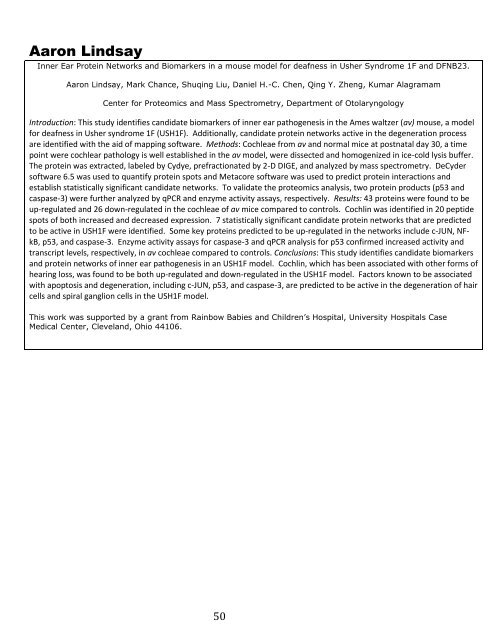student research day - Case Western Reserve University School of ...
student research day - Case Western Reserve University School of ...
student research day - Case Western Reserve University School of ...
Create successful ePaper yourself
Turn your PDF publications into a flip-book with our unique Google optimized e-Paper software.
Aaron Lindsay<br />
Inner Ear Protein Networks and Biomarkers in a mouse model for deafness in Usher Syndrome 1F and DFNB23.<br />
Aaron Lindsay, Mark Chance, Shuqing Liu, Daniel H.-C. Chen, Qing Y. Zheng, Kumar Alagramam<br />
Center for Proteomics and Mass Spectrometry, Department <strong>of</strong> Otolaryngology<br />
Introduction: This study identifies candidate biomarkers <strong>of</strong> inner ear pathogenesis in the Ames waltzer (av) mouse, a model<br />
for deafness in Usher syndrome 1F (USH1F). Additionally, candidate protein networks active in the degeneration process<br />
are identified with the aid <strong>of</strong> mapping s<strong>of</strong>tware. Methods: Cochleae from av and normal mice at postnatal <strong>day</strong> 30, a time<br />
point were cochlear pathology is well established in the av model, were dissected and homogenized in ice-cold lysis buffer.<br />
The protein was extracted, labeled by Cydye, prefractionated by 2-D DIGE, and analyzed by mass spectrometry. DeCyder<br />
s<strong>of</strong>tware 6.5 was used to quantify protein spots and Metacore s<strong>of</strong>tware was used to predict protein interactions and<br />
establish statistically significant candidate networks. To validate the proteomics analysis, two protein products (p53 and<br />
caspase-3) were further analyzed by qPCR and enzyme activity assays, respectively. Results: 43 proteins were found to be<br />
up-regulated and 26 down-regulated in the cochleae <strong>of</strong> av mice compared to controls. Cochlin was identified in 20 peptide<br />
spots <strong>of</strong> both increased and decreased expression. 7 statistically significant candidate protein networks that are predicted<br />
to be active in USH1F were identified. Some key proteins predicted to be up-regulated in the networks include c-JUN, NFkB,<br />
p53, and caspase-3. Enzyme activity assays for caspase-3 and qPCR analysis for p53 confirmed increased activity and<br />
transcript levels, respectively, in av cochleae compared to controls. Conclusions: This study identifies candidate biomarkers<br />
and protein networks <strong>of</strong> inner ear pathogenesis in an USH1F model. Cochlin, which has been associated with other forms <strong>of</strong><br />
hearing loss, was found to be both up-regulated and down-regulated in the USH1F model. Factors known to be associated<br />
with apoptosis and degeneration, including c-JUN, p53, and caspase-3, are predicted to be active in the degeneration <strong>of</strong> hair<br />
cells and spiral ganglion cells in the USH1F model.<br />
This work was supported by a grant from Rainbow Babies and Children’s Hospital, <strong>University</strong> Hospitals <strong>Case</strong><br />
Medical Center, Cleveland, Ohio 44106.<br />
50
















